In the spring of 2018, the U.S. Equal Employment Opportunity Commission received its first budget increase in over eight years, with Congress approving approximately $16 million for the agency to focus on sexual harassment claims.
In October of 2018, the EEOC released preliminary data on sexual harassment claims for 2018, which reflected an uptick in lawsuits and charges of discrimination. On April 10, 2019, the EEOC released its final enforcement and litigation data for fiscal year 2018, which ended September 30, 2018.
As expected, the statistics show a significant increase in the number of sexual harassment charges of discrimination in the wake of the #MeToo Movement. Although the data shows that retaliation continues to be the most frequently filed charge with the agency, the EEOC reported a 13.6% increase in the filing of sexual harassment charges from FY 2017 to FY 2018. The EEOC also reported recovering $56.6 million for victims of sexual harassment, an increase of more than $10 million from the year prior.
The EEOC filed 66 lawsuits challenging workplace harassment in 2018, 41 of which alleged sexual harassment. This is more than a 50% increase in suits challenging sexual harassment over FY 2017. The agency also reported that it has decreased its backlog of charges.
In addition, on April 2, 2019, Navex Global, a leading ethics and compliance software and services company, reported an overall 18% increase in harassment reports during 2017 and 2018.

What the statistics demonstrate
The #MeToo Movement went viral back in October of 2017, when the New York Times broke the Harvey Weinstein sexual harassment story. These recently released statistics demonstrate a few things.
-
First, the EEOC now has increased funding to continue its renewed focus on eliminating sexual harassment in the workplace.
-
Second, the EEOC has actively applied those resources as evidenced by its increase in lawsuits filed and settlement dollars recovered.
-
Third, emboldened by the movement and the creation of a culture willing to speak out against sexual harassment, employees are beginning to internally report sexual harassment with more frequency and have submitted more charges to the EEOC.
-
And fourth, the EEOC’s commitment to the #MeToo Movement appears to be a long-term and effective strategy for the agency.
What this means for employers
These statistics serve as a reminder for employers to review and update their anti-harassment policies and procedures. Employers must provide effective complaint mechanisms that allow alleged victims to bypass alleged harassers. Employees should be encouraged to make reports, and employers must investigate them in a prompt and objective manner, taking appropriate action to immediately stop harassment. Employers should also be training their entire workforce, not just supervisors, on a regular basis so that everyone knows their rights and remedies. If faced with a sexual harassment complaint, employers should consider outsourcing the investigation under certain circumstances. Ultimately, in order to determine the best course of action, employers should consider consulting a labor and employment attorney.